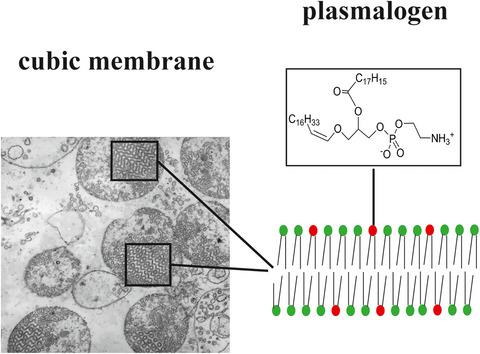当前位置:
X-MOL 学术
›
FEBS Open Bio
›
论文详情
Our official English website, www.x-mol.net, welcomes your
feedback! (Note: you will need to create a separate account there.)
Plasmalogen-rich foods promote the formation of cubic membranes in amoeba Chaos under stress conditions
FEBS Open Bio ( IF 2.8 ) Pub Date : 2021-06-29 , DOI: 10.1002/2211-5463.13241 Ketpin Chong 1 , Zakaria A Almsherqi 1 , Ruijiang Zhuo 2 , Yuru Deng 2, 3
FEBS Open Bio ( IF 2.8 ) Pub Date : 2021-06-29 , DOI: 10.1002/2211-5463.13241 Ketpin Chong 1 , Zakaria A Almsherqi 1 , Ruijiang Zhuo 2 , Yuru Deng 2, 3
Affiliation

|
Previous studies have indicated that the ability to form cubic membrane (CM), a three-dimensional periodic structure with cubic symmetry, in amoeba (Chaos carolinense) under stress conditions depends on the type of food organism supplied before cell starvation. The significant increase in docosapentaenoic acid (DPA; C22:5n-6) during the starvation period has been reported to induce CM formation and support Chaos cell survival. In this article, we further investigated the lipid profiles of food organisms of the Chaos cells to reveal the key lipid components that might promote CM formation. Our results show that the lipids extracted from cells of the native food organism Paramecium multimicronucleatum are enriched in plasmalogens. More specifically, plasmalogen phosphatidylcholine and plasmalogen phosphatidylethanolamine might be the key lipids that trigger CM formation in Chaos cells under starvation stress conditions. Unexpectedly, CM formation in these cells is not supported when the native food organism was replaced with plasmalogen-deficit Tetrahymena pyriformis cells. Based on a previous lipidomics study on amoeba Chaos and this study on the lipid composition of its food organisms, three key lipids (plasmalogen phosphatidylcholine, plasmalogen phosphatidylethanolamine and diacyl-phosphatidylinositol) were identified and used for liposomal construction. Our in vitro study revealed the potential role of these lipids in a nonlamellar phase transition. The negative staining transmission electron microscopy data of our liposomal constructs support the notion that plasmalogens may curve the membrane, which, in turn, may facilitate membrane fusion and vesicular formation, which is crucial for membrane dynamics and trafficking.
中文翻译:

富含缩醛磷脂的食物促进阿米巴混沌在应激条件下立方膜的形成
先前的研究表明,阿米巴变形虫(Chaos carolinense)在应激条件下形成立方膜(CM)(一种具有立方对称性的三维周期性结构)的能力取决于细胞饥饿前提供的食物生物的类型。据报道,饥饿期间二十二碳五烯酸(DPA;C22:5n-6)显着增加,可诱导 CM 形成并支持Chaos细胞存活。在本文中,我们进一步研究了混沌细胞食物生物的脂质谱,以揭示可能促进 CM 形成的关键脂质成分。我们的结果表明,从本土食物生物草履虫细胞中提取的脂质富含缩醛磷脂。更具体地说,缩醛磷脂磷脂酰胆碱和缩醛磷脂磷脂酰乙醇胺可能是在饥饿应激条件下触发混沌细胞中CM形成的关键脂质。出乎意料的是,当用缩醛磷脂缺陷的梨形四膜虫细胞替代天然食物生物时,这些细胞中的CM形成不受支持。基于之前对阿米巴混沌的脂质组学研究以及本次对其食物生物体脂质组成的研究,确定了三种关键脂质(缩醛磷脂磷脂酰胆碱、缩醛磷脂磷脂酰乙醇胺和二酰基磷脂酰肌醇)并将其用于脂质体构建。我们的体外研究揭示了这些脂质在非层状相变中的潜在作用。我们的脂质体构建体的负染色透射电子显微镜数据支持缩醛磷脂可能使膜弯曲的观点,这反过来又可能促进膜融合和囊泡形成,这对于膜动力学和运输至关重要。
更新日期:2021-08-03
中文翻译:

富含缩醛磷脂的食物促进阿米巴混沌在应激条件下立方膜的形成
先前的研究表明,阿米巴变形虫(Chaos carolinense)在应激条件下形成立方膜(CM)(一种具有立方对称性的三维周期性结构)的能力取决于细胞饥饿前提供的食物生物的类型。据报道,饥饿期间二十二碳五烯酸(DPA;C22:5n-6)显着增加,可诱导 CM 形成并支持Chaos细胞存活。在本文中,我们进一步研究了混沌细胞食物生物的脂质谱,以揭示可能促进 CM 形成的关键脂质成分。我们的结果表明,从本土食物生物草履虫细胞中提取的脂质富含缩醛磷脂。更具体地说,缩醛磷脂磷脂酰胆碱和缩醛磷脂磷脂酰乙醇胺可能是在饥饿应激条件下触发混沌细胞中CM形成的关键脂质。出乎意料的是,当用缩醛磷脂缺陷的梨形四膜虫细胞替代天然食物生物时,这些细胞中的CM形成不受支持。基于之前对阿米巴混沌的脂质组学研究以及本次对其食物生物体脂质组成的研究,确定了三种关键脂质(缩醛磷脂磷脂酰胆碱、缩醛磷脂磷脂酰乙醇胺和二酰基磷脂酰肌醇)并将其用于脂质体构建。我们的体外研究揭示了这些脂质在非层状相变中的潜在作用。我们的脂质体构建体的负染色透射电子显微镜数据支持缩醛磷脂可能使膜弯曲的观点,这反过来又可能促进膜融合和囊泡形成,这对于膜动力学和运输至关重要。


















































 京公网安备 11010802027423号
京公网安备 11010802027423号